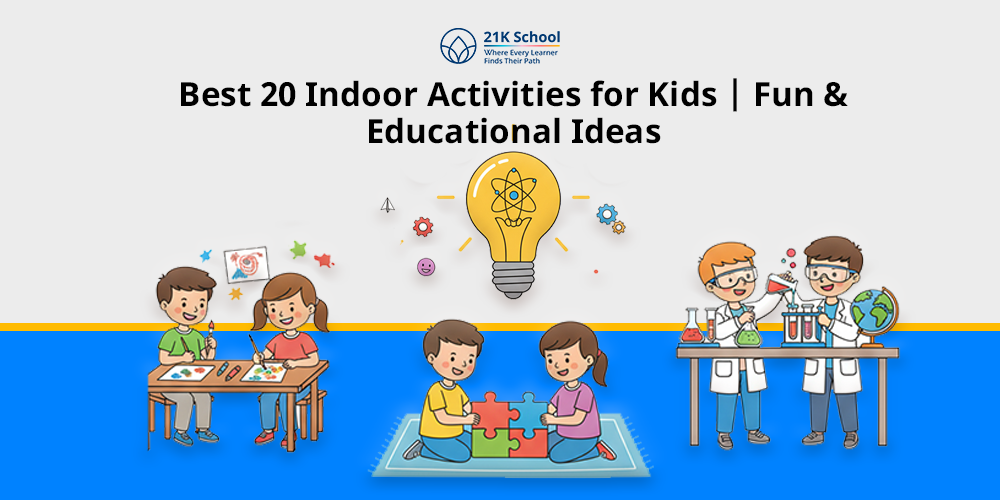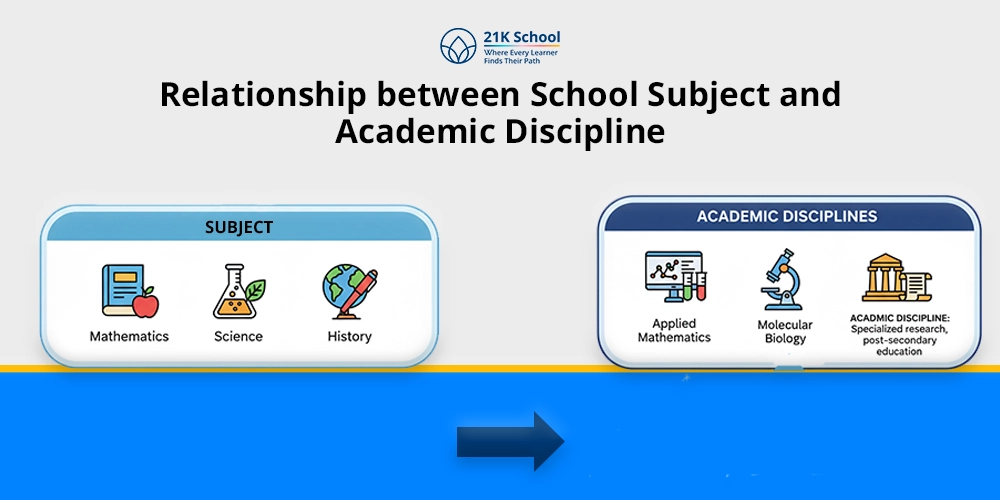
Do you have trouble keeping kids occupied? Here are some indoor activities for kids!
Kids get bored and forget things. In those cases you have to give them activities and games. In summer or winter, the child can have indoor games.
Indoor activities like art and craft, drawing, puzzles, memory games, book reading etc.
Fine motor & gross motor skills develop in activities for kids – academically as well as socially. Activities also support critical thinking in children.
Table of Contents
- Indoor Activities for Kids: Top 20 Activities
- 1. Drawing and Painting
- 2. Puzzle
- 3. Indoor Treasure Hunt
- 4. Yoga Exercises
- 5. Science Experiments
- 6. Memory Card Game
- 7. Indoor Picnic
- 8. Role Playing
- 9. Building Blocks
- 10. Alphabet Hunt
- 11. Musical Chair
- 12. Balloon Tennis
- 13. Sticker Collection
- 14. Simple Cooking
- 15. Indoor Gardening
- 16. Riddles
- 17. Book Reading
- 18. Create a Craft Museum
- 19. Board Games
- 20. Dance Party
- Ending Note
Indoor Activities for Kids: Top 20 Activities
Most indoor activities permit students to study and exercise at home. During summer holidays kids can play indoors without being bored at home. The following are the best indoor activities for kids.
1. Drawing and Painting
Drawing and painting are indoor activities that are easy. The children can draw or paint their imaginings and visions.
Kids can make shapes or scenes with crayons, colored pencils, watercolours, finger paints etc. They teach fine motor control, hand eye coordination and colour recognition. Emotionally it is also a good activity – feelings can be released.
2. Puzzle
Another indoor game is puzzles which teaches kids about many aspects and connections. They are jigsaw or logic problems or pattern matching.
Puzzle work teaches critical thinking, spatial awareness & problem-solving in children. It also teaches students patience and persistence. That indoor puzzle has educational value too – and it feels good to solve it!
3. Indoor Treasure Hunt
In an indoor treasure hunt, children search around the house for clues. Here, kids can experience a treasure hunt for themselves. If done in groups it teaches reading comprehension, reasoning and teamwork.
Parents choose how difficult the clues are for each child based on their age and interests. Treasure hunts can also be educational in nature – find things by colour, shape or first letter. It’s a low-cost activity that combines fun with learning in a positive learning environment.
4. Yoga Exercises
Another indoor activity is yoga. In yoga for children we teach flexibility and balance, strength and relaxation and mindfulness exercises.
Basic kid’s poses like Marjaryasana, Tadasana, Virabhadrasana, Sukhasana, etc can be done by students too. Yoga classes help with developing healthy habits early on and give a break from screens/other high-energy activities.
5. Science Experiments
Science experiments can be so interesting to students. Science experiments show kids the real world. They learn best by doing rather than by passive or rote learning.
Creating a baking soda and vinegar volcano, growing crystals or colouring a glass of water are all good ways to learn about science.
6. Memory Card Game
Memory card games for kids also put pairs of cards face down. That teaches children cognitive learning skills. Card games help with memory, concentration and visual identification. It is a social game whether played solo or in teams.
It teaches visual discrimination as well as logical thinking without screens or expensive materials to keep kids amused and mentally active.
7. Indoor Picnic
Take a picnic indoors for mealtime fun. Children can make sandwiches, fruit or finger foods and put a picnic blanket in the living room or playroom. This is a new kind of eating which also helps with communication & bonding.
They might also make picnics for children at home and establish parent-child relations.
8. Role Playing
Role-playing is fun indoors, alone or with friends. Role-playing helps kids picture other peoples’ positions and opinions. Role playing makes them more creative, social, empathetic, and so on.
Role playing is getting kids to be a doctor or a teacher or a superhero or even a shopkeeper. It is for kids who are creative, social and want to hear other perspectives.
9. Building Blocks
Building blocks, construction toys help with creativity, spatial reasoning and fine motor skills. Kids build structures, vehicles or other imaginative things with LEGO.
Kids design ways to balance pieces during this activity. It also teaches engineering concepts – good for STEM learning. It’s an eternal indoor activity for children and young people of all ages – cognitive and creative.
10. Alphabet Hunt
In an alphabet hunt, kids look for letters around the home. Looking for letters of the alphabet is called an alphabet hunt. Students learn the alphabet this way.
It helps with letter recognition, vocabulary & phonics. It also contains observations for students learning to talk. The hunt makes learning move and it is a good kinesthetic learning practice.
11. Musical Chair
Musical chairs is an indoor game of music, movement and quick thinking. Chairs around which children walk as music plays. When it stops everyone sits down. One chair goes away every round and the child standing is out.
That teaches hand-eye coordination & cooperation. Musical chairs keeps children physically active while they develop social and motor coordination in a fun learning environment.
12. Balloon Tennis
Indoor balloon tennis is played with flimsy rackets. That teaches you hand-eye coordination and gross motor skills. You can play indoors – the balloons are soft.
You can play balloon tennis in a tight space for exercise on rainy days, or in an apartment. It’s easy to put together, endlessly fun and moves children while improving focus & agility.
13. Sticker Collection
Some kids have stickers or badges. Kids may organise stickers too – and become more organised. They teach fine motor skills and creative thinking skills.
Sticker categorisation and sorting also teaches theme, colour and size labelling. It’s a hobby without screens that kids can do and which they can own.
14. Simple Cooking
Cooking is another indoor activity. Sandwiches, fruit salads, sweet treats with children teach measuring and following instructions.
Cooking together teaches kids independence and nutrition. It will also get them into cooking. Whether it’s stirring, pouring or decorating – even simple cooking is a lesson in family bonding and practical knowledge.
15. Indoor Gardening
Through indoor gardening students can learn about plants and their growing stages. Indoor gardening teaches kids about plants and responsibility. Kids can plant seeds in a pot – coriander, basil, gram, mint etc.
So patience, observation and care of living things are necessary. It can go with lessons on nature, seasons and environment. Indoor gardening is relaxing and therapeutic – it lowers student stress and increases a child’s curiosity about nature.
16. Riddles
Riddles are good for language, logic and critical thinking indoors. Riddles for children – great indoor activity! Riddles require imagination, logic, vocabulary & metacognition.
Listening and communicating in a social setting is called puzzle sharing. Parents make them age-and interest-appropriate riddles.
17. Book Reading
For kids it is one of the most enjoyable indoor activities to read stories. You learn language, imagination and emotional intelligence. Reading books aloud alone helps with literacy, imagination and concentration.
Storytime can be interactive with questions. Reading exposes them to other ideas and cultures as well as to emotional intelligence.
18. Create a Craft Museum
It is a craft museum where children can show their work and feel more confident. Make some different crafts for children with paper and glues, recycled material and art supplies put in a museum.
It teaches creative thinking skills and organisational pride. It is also a place for art and presentation and storytelling.
19. Board Games
Board games are critical thinking, strategic planning, and social games for children indoors. Board games teach cooperation & turn taking. They can be little games for babies or big games for older kids and families.
Playing board games teaches social interaction, patience as well as cognitive skills through counting, reading and planning.
20. Dance Party
Dance parties help children burn off energy and develop coordination. Favorite tunes and free movement rhythm balance and gross motor development.
Dancing improves coordination, balance, rhythm and physical fitness and is a stress reliever. Dancing also lifts mood and in groups it helps with collaboration skills.
Ending Note
Indoor activities keep kids and educated all year round – in any weather or season.
Play time with parents might be creative, physical and educational. Parents can promote whole child development in fine motor and critical thinking and social and emotional development.
Whether it is rainy days or warm nights at home – indoor activities are family bonding activities which promote lifelong learning curiosity in children.


